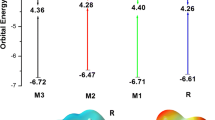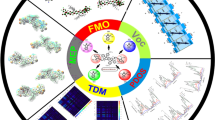Abstract
The design and fabrication of solar cells have recently witnessed the exploration of non-fullerene-based acceptor molecules for higher efficiency. In this study, the optical and electronic properties of four new three-dimensional (3D) star-shaped acceptor molecules (M1, M2, M3, and M4) are evaluated for use as acceptor molecules in organic solar cells. These molecules contain a triphenylamine donor core with diketopyrrolopyrrole acceptor arms linked via a thiophene bridge unit. Molecules M1–M4 are characterized by different end-capped acceptor moieties, including 2-(5-methylene-6-oxo-5,6-dihydrocyclopenta-b-thiophen-4-ylidene)malononitrile (M1), 2-(2-methylene-3-oxo-2,3-dihydroinden-1-ylidene)malononitrile (M2), 2-(5-methyl-2-methylene-3-oxo-2,3-dihydroinden-1-ylidene)malononitrile (M3), and 3-methyl-5-methylnene-thioxothiazolidin-4-one (M4). The properties of the newly designed molecules were compared with a well-known reference compound R, which was recently reported as an excellent acceptor molecule for organic solar cells. Molecules M1–M4 exhibit suitable frontier molecular orbital patterns for charge mobility. M2 shows maximum absorption (λmax) at 846.8 nm in dichloromethane solvent, which is ideal for the design of transparent solar cells. A strong electron withdrawing end-capped acceptor causes a red shift in absorption spectra. All molecules are excellent for hole mobility due to a lower value of λh compared to the reference R.

Here, we have designed four new triphenylamine-based three-dimensional star-shaped electron acceptors with different electron withdrawing end-capped acceptor moieties, namely M1, M2, M3, and M4) for opto-electronic properties of organic solar cells. The designed star-shaped acceptor molecules show excellent optoelectronic properties with respect to reference compound R.








Similar content being viewed by others
References
Klass DL (1998) Biomass for renewable energy, fuels, and chemicals. Elsevier, Amsterdam
Douglas G, McCarthy K, Dahlen D, Seavey J, Steinhauer W, Prince R, Elmendorf D (1992) The use of hydrocarbon analyses for environmental assessment and remediation. Soil Sediment Contam 1(3):197–216
Carlson CL, Adriano DC (1993) Environmental impacts of coal combustion residues. J Environ Qual 22(2):227–247
Ans M, Ayub K, Bhatti IA, Iqbal J (2019) Designing indacenodithiophene based non-fullerene acceptors with a donor–acceptor combined bridge for organic solar cells. RSC Adv 9(7):3605–3617
Herzog AV, Lipman TE, Kammen DM (2001) Renewable energy sources. Encyclopedia of life support systems (EOLSS) forerunner volume ‘Perspectives and overview of life support systems and sustainable development. University of California, Berkeley
Johansson TB, Burnham L (1993) Renewable energy: sources for fuels and electricity. Island, Washington
Panwar N, Kaushik S, Kothari S (2011) Role of renewable energy sources in environmental protection: a review. Renew Sust Energ Rev 15(3):1513–1524
Griffith S, Lynn P, Hardham C (2010) Wind power generation. Google Patents US7847426B1
Nilges P, Schröder U (2013) Electrochemistry for biofuel generation: production of furans by electrocatalytic hydrogenation of furfurals. Energy Environ Sci 6(10):2925–2931
Baarman DW, Leppien T, Lautzenheiser TL, Houghton CB, McPhilliamy SJ (2010) Hydro-power generation system. Google Patents US20050017513A1
Carlson DE, Wronski CR (1976) Amorphous silicon solar cell. Appl Phys Lett 28(11):671–673
Cheng Y-J, Yang S-H, Hsu C-S (2009) Synthesis of conjugated polymers for organic solar cell applications. Chem Rev 109(11):5868–5923
Lin Y, Li Y, Zhan X (2012) Small molecule semiconductors for high-efficiency organic photovoltaics. Chem Soc Rev 41(11):4245–4272
Günes S, Neugebauer H, Sariciftci NS (2007) Conjugated polymer-based organic solar cells. Chem Rev 107(4):1324–1338
Roes A, Alsema E, Blok K, Patel MK (2009) Ex-ante environmental and economic evaluation of polymer photovoltaics. Prog Photovolt Res Appl 17(6):372–393
Heeger AJ (2010) Semiconducting polymers: the third generation. Chem Soc Rev 39(7):2354–2371
Dou L, You J, Hong Z, Xu Z, Li G, Street RA, Yang Y (2013) 25th anniversary article: a decade of organic/polymeric photovoltaic research. Adv Mater 25(46):6642–6671
Ans M, Iqbal J, Ayub K, Ali E, Eliasson B (2019) Spirobifluorene based small molecules as an alternative to traditional fullerene acceptors for organic solar cells. Mater Sci Semicond Process 94:97–106
Benson-Smith JJ, Goris L, Vandewal K, Haenen K, Manca JV, Vanderzande D, Bradley DD, Nelson J (2007) Formation of a ground-state charge-transfer complex in Polyfluorene//[6, 6]-phenyl-C61 butyric acid methyl Ester (PCBM) blend films and its role in the function of polymer/PCBM solar cells. Adv Funct Mater 17(3):451–457
He Y, Li Y (2011) Fullerene derivative acceptors for high performance polymer solar cells. Phys Chem Chem Phys 13(6):1970–1983
Chirvase D, Chiguvare Z, Knipper M, Parisi J, Dyakonov V, Hummelen J (2003) Temperature dependent characteristics of poly (3 hexylthiophene)-fullerene based heterojunction organic solar cells. J Appl Phys 93(6):3376–3383
Lin Y, Zhan X (2015) Oligomer molecules for efficient organic photovoltaics. Acc Chem Res 49(2):175–183
Xie D, Liu T, Gao W, Zhong C, Huo L, Luo Z, Wu K, Xiong W, Liu F, Sun Y (2017) A novel thiophene-fused ending group enabling an excellent small molecule acceptor for high-performance fullerene-free polymer solar cells with 11.8% efficiency. Solar RRL 1(6):1700044
Zhao W, Li S, Yao H, Zhang S, Zhang Y, Yang B, Hou J (2017) Molecular optimization enables over 13% efficiency in organic solar cells. J Am Chem Soc 139(21):7148–7151
Lin Y, Cheng P, Li Y, Zhan X (2012) A 3D star-shaped non-fullerene acceptor for solution-processed organic solar cells with a high open-circuit voltage of 1.18 V. Chem Commun 48(39):4773–4775
Frisch M, Trucks G, Schlegel H, Scuseria G, Robb M, Cheeseman J, Scalmani G, Barone V, Mennucci B, Petersson G (2017) Gaussian 09 revision A.1. Gaussian, Inc., Wallingford
Dennington RD, Keith TA, Millam JM (2008) GaussView 5.0. 8. Gaussian Inc., Wallingford
Adamo C, Barone V (1998) Exchange functionals with improved long-range behavior and adiabatic connection methods without adjustable parameters: the m PW and m PW1PW models. J Chem Phys 108(2):664–675
Chai J-D, Head-Gordon M (2008) Long-range corrected hybrid density functionals with damped atom–atom dispersion corrections. Phys Chem Chem Phys 10(44):6615–6620
Civalleri B, Zicovich-Wilson CM, Valenzano L, Ugliengo P (2008) B3LYP augmented with an empirical dispersion term (B3LYP-D*) as applied to molecular crystals. CrystEngComm 10(4):405–410
DiLabio GA, Johnson ER, Otero-de-la-Roza A (2013) Performance of conventional and dispersion-corrected density-functional theory methods for hydrogen bonding interaction energies. Phys Chem Chem Phys 15(31):12821–12828
Yanai T, Tew DP, Handy NC (2004) A new hybrid exchange–correlation functional using the coulomb-attenuating method (CAM-B3LYP). Chem Phys Lett 393(1–3):51–57
Cossi M, Barone V, Mennucci B, Tomasi J (1998) Ab initio study of ionic solutions by a polarizable continuum dielectric model. Chem Phys Lett 286(3–4):253–260
Zhang J-H, Su Y-Z, Song J-H, Quo H-Y (2003) Three dimensional graphs of the wave functions in origin 6.0. Comput Appl Chem 20(5):627–630
Tenderholt AL (2019) PyMOlyze: a program to analyze quantum chemistry calculations, version 2.0. https://pymolyze.soft112.com/
Ans M, Iqbal J, Eliasson B, Ayub K (2019) Opto-electronic properties of non-fullerene fused-undecacyclic electron acceptors for organic solar cells. Comput Mater Sci 159:150–159
Ans M, Iqbal J, Ahmad Z, Muhammad S, Hussain R, Eliasson B, Ayub K (2018) Designing three-dimensional (3D) non-fullerene small molecule acceptors with efficient photovoltaic parameters. ChemistrySelect 3(45):12797–12804
Takacs CJ, Sun Y, Welch GC, Perez LA, Liu X, Wen W, Bazan GC, Heeger AJ (2012) Solar cell efficiency, self-assembly, and dipole–dipole interactions of isomorphic narrow-band-gap molecules. J Am Chem Soc 134(40):16597–16606
Scharber MC, Mühlbacher D, Koppe M, Denk P, Waldauf C, Heeger AJ, Brabec CJ (2006) Design rules for donors in bulk-heterojunction solar cells—towards 10% energy-conversion efficiency. Adv Mater 18(6):789–794
Acknowledgments
The Computations/simulations/SIMILAR were performed on resources provided by the Swedish National Infrastructure for Computing (SNIC) at Umeå University, 901 87, Umeå, Sweden. The authors acknowledge the financial and technical support from Punjab Bio-energy Institute (PBI), University of Agriculture Faisalabad (UAF).
Author information
Authors and Affiliations
Corresponding author
Additional information
Publisher’s note
Springer Nature remains neutral with regard to jurisdictional claims in published maps and institutional affiliations.
Electronic supplementary material
ESM 1
(DOCX 36 kb)
Rights and permissions
About this article
Cite this article
Ans, M., Iqbal, J., Eliasson, B. et al. Designing of non-fullerene 3D star-shaped acceptors for organic solar cells. J Mol Model 25, 129 (2019). https://doi.org/10.1007/s00894-019-3992-9
Received:
Accepted:
Published:
DOI: https://doi.org/10.1007/s00894-019-3992-9




